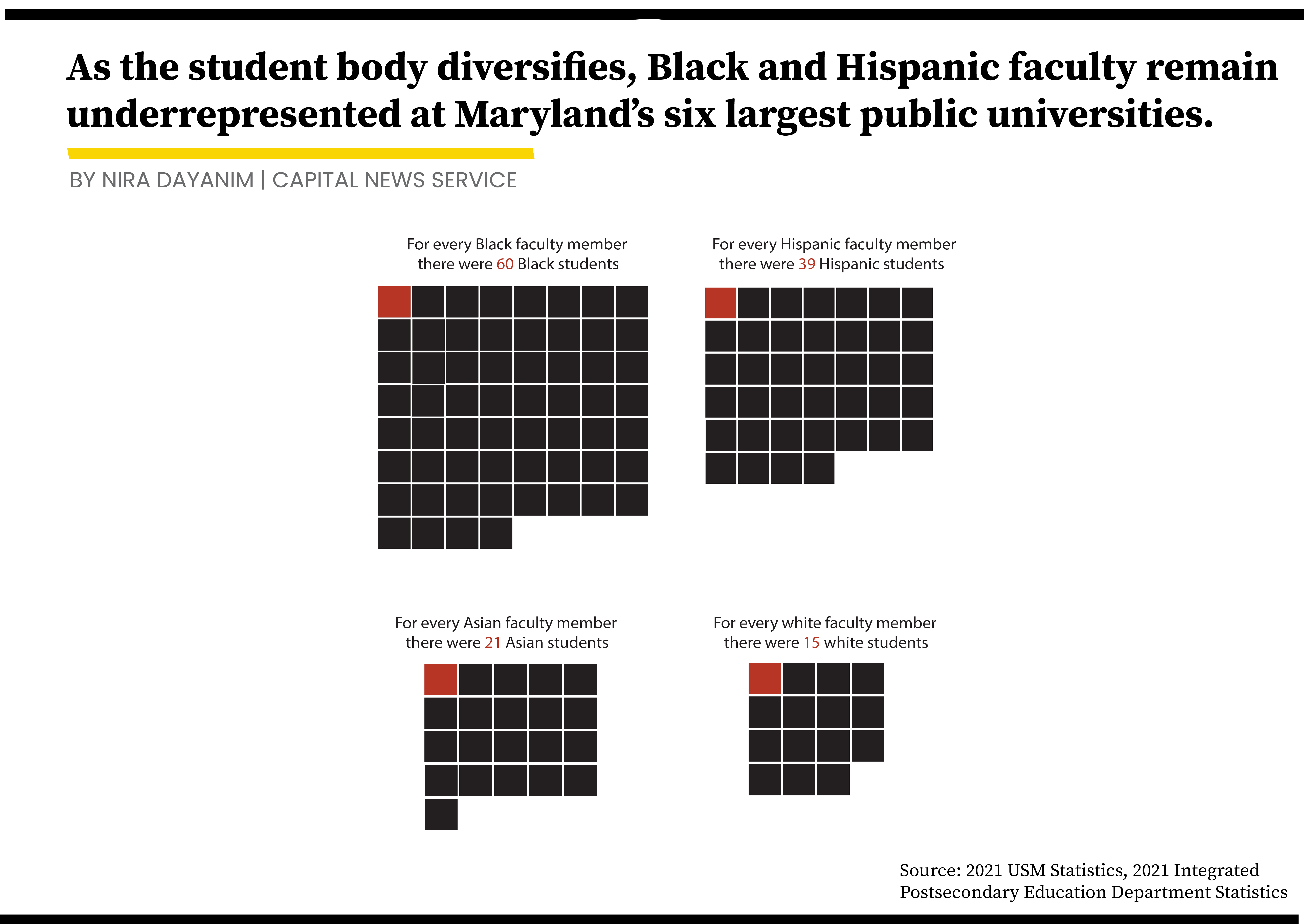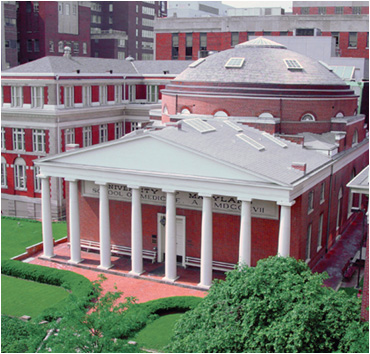BY NIRA DAYANIM
Black and Hispanic communities are underrepresented among university faculty at Maryland’s six largest public universities, according to the 2021 Integrated Postsecondary Education Data System (IPEDS). This analysis does not include Maryland’s online universities or historically black colleges and universities.
IPEDS is an annual data collection system run through the U.S. Department of Education.
These findings align with trends across the country, data shows. Maryland is the fourth most diverse U.S. state, according to the U.S. Census’ diversity index, and the most diverse state on the East Coast, according to the U.S. News and World Report.
The U.S. Census projects that 32% of Maryland’s population are Black and 12% are Hispanic. At Maryland’s six largest in-person public universities, not including HBCUs – University of Maryland, Baltimore County; University of Maryland, College Park; Towson University; Frostburg State University; Salisbury University and St. Mary’s College of Maryland– less than 6% of the total faculty are Black and less than 5% are Hispanic, as of 2021.
According to Laura Perna, Vice Provost for Faculty at University of Pennsylvania and a researcher on college access, faculty underrepresentation is a widespread issue, though the specifics differ by university.
Across Maryland, faculty demographics vary widely. At Towson University, 7% of faculty were Black in fall 2021 and 3% were Hispanic. At Frostburg State University, those numbers were about halved, with 4% Black faculty and almost 1% Hispanic faculty.
Prior to 2022, Maryland’s education code allowed individual public universities to implement their own plans for “cultural diversity,” which ranged in length and breadth. In 2022, a new code was instituted, requiring public universities to ensure that faculty, staff, and administration demographics reflect the state’s diverse population.
Between 2016 and 2021, the percentages of Black and Hispanic faculty at the universities included in the analysis both increased by just under a percentage point.
“It really is amazing how little progress there has been in some ways on this,” said Perna.
But not unexpected, according to Perna. Because positions open when current faculty members retire, seeing an increase in representation might take time.
According to Dr. Kimberly Griffin, Dean of the University of Maryland’s College of Education, many people assume that faculty will diversify alongside the student body. This “trickle-up” system is unrealistic, she said.
The problem is multifaceted, Griffin said. Academia is tasked with generating a pool, hiring inclusively, yielding candidates, onboarding hires, retaining them, and ultimately, promoting them. “We have to do more in all of those spaces,” said Griffin, whose research has, for years, focused on issues of diversity, equity, and inclusion in post-secondary education.
According to Perna, one roadblock is “invisible labor”; faculty of color often take on work that requires time and energy, but does not fit academia’s standard promotion metrics.
“We should be looking at to what extent our definition of merit is very narrow,” Perna said.
Underrepresented minorities often spend more time serving on committees and mentoring students of color, labor that often goes unrecognized, said Perna. Time for promotions, publications and course evaluations are weighted more heavily.
Research may also go unappreciated. According to Griffin, members of minority groups often pursue research in applied topics, like solutions to community issues.
“Bias that we have around what good work looks like, and what’s meaningful can shape how the tenure and promotion cases of women and men of color are perceived,” Griffin said.
As the student body has diversified, the gap between representation among students and faculty has widened, straining faculty of color.
As of fall 2021, Black students made up 17% and Hispanic students made up 8% of the student body at the universities included in the CNS analysis. That was an increase of 10% and 19% since 2016, respectively. Faculty demographics remained stable.
In 2021, the resulting ratio of Black students to Black faculty members was 60:1. The ratio of white students to white faculty members was 15:1.
According to Griffin, while it’s crucial for students of color to have role models and mentors of color, there isn’t enough faculty of color to shoulder that responsibility alone. “That’s a load everyone should share,” she said.
A lack of diversity also impacts faculty of color pursuing tenure. At Maryland’s six largest in-person public universities, not including HBCUs, in 2021, 71% of tenured professors were white, 5% Black, and 4% were Hispanic, according to IPEDS.
Across all six universities in 2021, there were 104 tenured Black professors, an increase of 3 professors from 2016, according to IPEDS. There were 10 more Black faculty members and 16 more Hispanic faculty members in tenure track positions than in 2016.
A lack of diversity among tenured faculty can make it harder for some faculty of color to find mentors as they pursue tenure, though many members of academia, like Griffin, are trying to combat this by developing an intentional mentoring policy.
“Mentorship that helps you build a sense of connection and community in your unit and in your college is also really important for helping folks get to tenure,” said Griffin.
Tenure and tenure track positions provide more job security than other faculty roles. In Maryland in 2021, 38% of Hispanic faculty and 30% of Black faculty were not tenured or on tenure track compared to 27% of white faculty.
Katharina Maisel, a bioengineering professor at the University of Maryland, College Park, co-authored a list of best practices for increasing diversity alongside several other faculty members in the STEM field.
According to Maisel, diversifying the faculty, especially tenure and tenure track, takes intention at every stage of the process, from inviting people to apply, inviting people for internships, and checking your shortlist to make sure you’re not just inviting people from Ivy League schools.
But it’s possible.
In science, technology, engineering, and math, said Maisel, a tendency to be overspecific in job listings can discourage faculty from underrepresented backgrounds. Being more broad can cut through imposter syndrome and help develop a wider applicant pool.
Using rubrics to evaluate a candidate for hiring or promotion can help ensure an objective set of criteria, helping reel in internal biases, Maisel said.
“If you as a department are really actively interested in increasing the diversity of your faculty, there are things you can do,” Maisel said.





Recent Comments